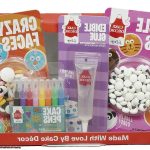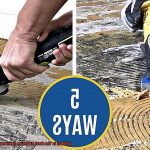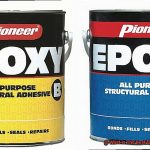Have you ever found yourself frustrated with wobbly chairs that threaten to collapse beneath you? It’s enough to make anyone want to toss them out the window. But before you give up on your beloved seating, let me share a little secret with you – chair repair is easier than you might think. And the key ingredient? The right adhesive.
When it comes to fixing chairs, there’s one glue that rises above the rest – epoxy resin adhesive. This stuff is like the superhero of adhesives, with its exceptional strength and durability. It’s like a knight in shining armor, ready to rescue your wobbly chairs from their impending doom.
But what makes epoxy resin adhesive so special? Well, for starters, it has an uncanny ability to bond different materials together. Wood? No problem. Metal? Piece of cake. Plastic? Consider it done. With this mighty adhesive by your side, you can rest assured knowing that your chair repairs will stand the test of time.
Say goodbye to those creaky, unstable seats and hello to sturdy seating that will hold up through countless family dinners and game nights. So don’t throw out those chairs just yet – grab yourself some epoxy resin adhesive and get ready for a chair repair adventure like no other.
Factors to Consider When Choosing the Best Glue for Chair Repair
Contents
Repairing chairs requires selecting the right glue for a durable and long-lasting fix. With numerous options available, it can be overwhelming to determine the best adhesive for chair repairs. This guide explores key factors to consider when selecting the perfect glue for chair repairs.
Factor 1: Adhesive Strength
- Pros: Choose glues specifically designed for furniture repairs or those with high bonding strength. These ensure firm and resilient bonds that withstand weight and pressure.
- Cons: Some glues prioritize faster drying times over bonding strength.
Factor 2: Drying Time
- Pros: Fast-drying glues are ideal for quick chair repairs, enabling prompt completion of the job.
- Cons: Certain fast-drying glues compromise bonding strength, so be mindful of this trade-off.
Factor 3: Compatibility
- Pros: Ensure chosen glue is compatible with your chair’s construction materials. This guarantees optimal adhesion and prevents damage to the chair.
- Cons: Incompatible glues may result in weak bonds or material damage.
Factor 4: Water Resistance
- Pros: Look for glues labeled as water-resistant or waterproof to protect repaired chairs from spills, humidity, or cleaning.
- Cons: Non-water-resistant glues may weaken or break down when exposed to moisture, compromising repair durability.
Factor 5: Flexibility
- Pros: Opt for a flexible adhesive that withstands movement and pressure without cracking or becoming brittle. This ensures your chair repair can handle frequent use.
- Cons: Rigid adhesives may lead to compromised bonds over time.
Factor 6: Ease of Use
- Pros: Choose glues with applicators or syringes for easy application in hard-to-reach areas. Easy cleanup options save time and effort.
- Cons: Some glues have complicated application processes or leave behind messy residue.
Factor 7: Safety
- Pros: Prioritize non-toxic glues that emit no harmful fumes. Low-odor or odorless options are ideal for poorly ventilated spaces.
- Cons: Toxic glues or working in poorly ventilated areas pose health risks.
Type of Chair Material
When it comes to choosing the best material for chairs, there are several factors to consider. Each material has its own pros and cons, and the right choice depends on the specific needs and preferences of the user. Let’s explore the different types of chair materials and their characteristics to determine which one is best.
- Wood: Wood is a timeless material used in chair construction, known for its durability and strength. Wooden chairs offer a classic aesthetic appeal and can complement various interior styles. They are sturdy and can withstand regular use. However, wood can be prone to scratches, dents, and warping over time. When it comes to repairing wooden chairs, two glue options stand out.
- Polyvinyl acetate (PVA) glue: PVA glue is a popular choice for woodworking projects and is perfect for repairing wooden chairs. It forms a strong bond, dries clear, and is easy to work with. It is suitable for both indoor and outdoor applications, making it a versatile choice.
- Epoxy adhesive: Epoxy offers exceptional bonding strength and durability, making it ideal for high-stress areas like chair legs or armrests. It consists of two components that need to be mixed before application, providing a strong bond that can withstand heavy use.
- Metal: Metal chairs are often found in outdoor or commercial settings due to their durability. They are resistant to weather elements and can withstand heavy use. However, metal chairs may not be as comfortable as other materials and can be prone to rust if not properly maintained. When it comes to repairing metal chairs, epoxy adhesive is your go-to option. Its exceptional bonding strength ensures a long-lasting repair. For smaller repairs on metal chairs, super glue can also be effective.
- Plastic: Plastic chairs are lightweight and versatile, making them a popular choice for both indoor and outdoor seating. They are affordable and easy to clean. However, plastic chairs may not offer the same level of durability and comfort as wood or metal chairs. When it comes to repairing plastic chairs, it’s important to choose the right adhesive.
- Solvent-based adhesives: These adhesives are specifically designed for bonding plastic materials and work by chemically melting the surfaces together. They provide a strong bond and are suitable for various types of plastic.
- Epoxy adhesives formulated for plastics: These specialized epoxy adhesives provide a strong and durable bond for repairing plastic chair parts.
Nature and Extent of Damage
The nature and extent of damage in chair repairs can vary greatly, requiring different approaches and adhesive solutions. Let’s take a closer look at the types of damage that chairs can sustain and the best ways to fix them.
Broken or loose joints are a common problem in chairs, especially those that have been well-loved over the years. When the glue holding the joints together weakens or fails, it can make the chair feel unstable and unsafe. To address this issue, epoxy glue is the ultimate hero. With its exceptional bonding properties, epoxy glue forms a durable bond that can withstand heavy loads. So, say goodbye to wobbly chairs and hello to stability.
Cracked or split wood is another type of damage that can significantly affect a chair’s structure and aesthetics. These imperfections can occur due to moisture exposure, temperature changes, or natural wear and tear. To mend those cracks and splits effectively, reach for cyanoacrylate glue, also known as super glue. This fast-drying adhesive seeps into the crevices and forms a strong bond that will have your chair looking as good as new.
But what about missing or damaged parts? Sometimes, a repair job goes beyond just gluing things back together. In these cases, it’s essential to use a combination of glue and reinforcement methods for a solid repair. Polyurethane glue or construction adhesive are excellent choices for these situations. These adhesives have exceptional bonding capabilities and can fill gaps seamlessly, providing the support your chair needs to withstand daily use.
Upholstery tears or stains may seem like a daunting challenge, but fear not. Fabric glue is here to save the day. Designed specifically for bonding fabrics together, fabric glue is ideal for minor tears or loose seams in your chair’s upholstery. And when it comes to stains or discoloration, specialized upholstery cleaners or stain removers are your best allies in restoring your chair’s beauty.
Desired Durability of the Repair
When it comes to repairing chairs, selecting the right glue is crucial for ensuring a long-lasting and reliable repair. One key factor to consider is the desired durability of the repair. In this article, we will delve into why durability is essential and explore different types of glues that offer superior strength and endurance for chair repairs.
Wood Glue
Wood glue is a true superhero when it comes to chair repair. It is a type of adhesive specifically designed for bonding wood surfaces together, making it an excellent choice for furniture repair and construction projects. Let’s explore the different types of wood glue available and their specific uses for chair repair.
- PVA Glue: Polyvinyl acetate glue, also known as PVA glue, is a popular choice for chair repair. It has a strong bond and is easy to use. Plus, cleanup is a breeze since it’s water-based. PVA glue dries relatively quickly, making it perfect for small chair repair projects where time is of the essence.
- Epoxy Resin Glue: When it comes to repairing broken or cracked wooden joints in chairs, epoxy resin glue is your go-to superhero. It’s a two-part adhesive that creates an incredibly strong and durable bond. Epoxy resin glue can handle high levels of stress and strain, ensuring your repaired chairs will stand strong for years to come. Plus, once dry, it can be sanded and painted over, giving your chairs a fresh new look.
- Polyurethane Glue: If you’re looking for a waterproof option for outdoor chair repairs or projects that require water resistance, polyurethane glue is here to save the day. This adhesive expands as it cures, creating a super-strong bond between wood surfaces.
Remember to consider factors like the type of wood being repaired, the size and complexity of the repair, and the desired strength and durability of the bond when choosing the best wood glue for your chair repair project. Always follow the manufacturer’s instructions for proper application and maximum bond strength.
Epoxy Adhesives
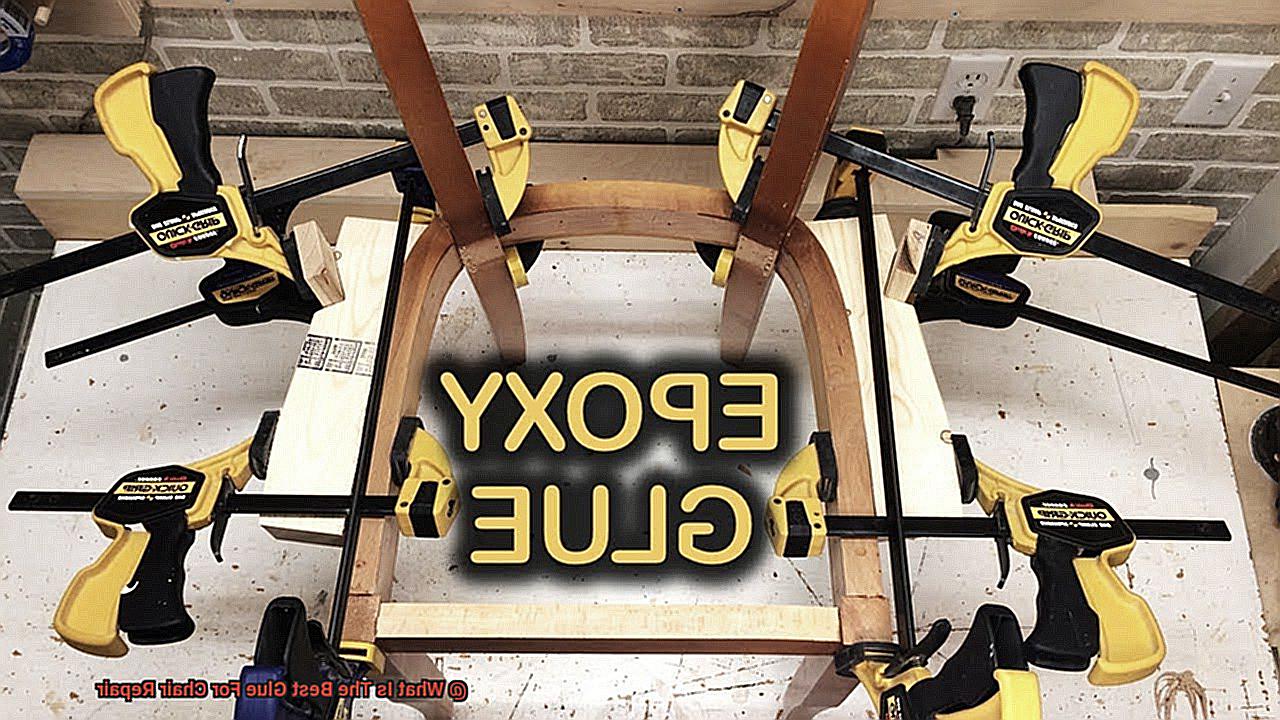
When it comes to chair repair, finding the right adhesive is crucial for ensuring a long-lasting and sturdy fix. Among the sea of options available, one adhesive stands out as the true superhero of the glue world – epoxy adhesives. In this article, we will delve into the remarkable advantages of using epoxy adhesives for chair repair and discover why they should be your go-to choice.
Unyielding Strength and Indestructible Durability:
Epoxy adhesives, composed of a potent blend of epoxy resin and hardener, create a chemical bond that leaves other glues in the dust. With their exceptional bonding strength and unparalleled durability, epoxy adhesives ensure that your repaired chair can withstand heavy loads and constant use without a hint of weakness.
The Perfect Match for All Materials:
Chairs often consist of a medley of materials – wood, metal, plastic, or fabric. Fortunately, epoxy adhesives are the chameleons of the adhesive world, adapting effortlessly to different materials. Whether you’re fixing a wooden chair with metal legs or a plastic chair with a fabric seat, epoxy adhesives provide an unbreakable bond that lasts for ages.
Filling in the Gaps with Perfection:
Repairing chairs often involves filling gaps or cracks to restore their structural integrity. Enter epoxy adhesives with their gap-filling prowess. Like skilled craftsmen, these adhesives seamlessly fill in any gaps or cracks, ensuring that your repaired chair remains as sturdy as ever. No more wobbles or creaks.
Defying the Elements:
Chairs face spills and exposure to all sorts of substances – indoors or outdoors. But fear not. Epoxy adhesives come armed with high resistance to moisture, oils, and various other chemicals. So, whether your chair faces a torrential downpour or an accidental coffee spill, epoxy adhesives keep it safe and intact. No more worries about water damage or chemical corrosion.
Fabric Glue/Upholstery Adhesive
Fabric glue, also known as upholstery adhesive, is the secret weapon you need. This versatile adhesive has the power to breathe new life into your favorite chair by effortlessly repairing tears, loose seams, and detached fabrics. Let’s explore what fabric glue is all about and how it can work wonders for upholstery repair.
Choosing the Perfect Sidekick:
- Upholstery-Specific Formulation: To ensure a successful repair, opt for fabric glue specifically designed for upholstery applications. These specialized adhesives are formulated to bond seamlessly with various chair fabrics, such as cotton, polyester, velvet, or even leather.
- Quick-Drying Power: Time is of the essence when it comes to chair repair. Look for a fabric glue that not only dries quickly but also guarantees a strong bond. However, be patient and allow the adhesive to fully cure before putting your chair back into action.
- Water-Resistance for Extra Protection: Accidents happen, especially with chairs. Choose a fabric glue that is water-resistant or waterproof to safeguard your repair against spills and moisture. This additional feature ensures long-lasting durability.
Unleashing the Superpowers:
- Prepare the Surface: Begin by cleaning and thoroughly drying the damaged area of the chair fabric. Remove any loose threads or debris that might hinder the bonding process.
- Apply Sparingly and Evenly: Utilize a small brush or nozzle to apply a thin layer of fabric glue to both surfaces you want to bond together. Remember, a little goes a long way.
- Press and Hold: Firmly press the glued surfaces together and hold them in place for the recommended time specified by the manufacturer’s instructions. Applying pressure guarantees proper adhesion and creates a strong bond.
- Follow Additional Instructions: Some fabric glues may require heat activation through ironing or drying in a clothes dryer. Always follow any additional instructions provided by the manufacturer to maximize the adhesive’s effectiveness.
Drying Time
When it comes to chair repair, selecting the perfect glue is essential for a successful and long-lasting fix. One often overlooked element that holds immense importance is the drying time of the glue. So, why is drying time such a crucial consideration? Let’s delve deeper into this topic.
First and foremost, drying time refers to the period it takes for the glue to fully dry and cure after application. Different glues boast varying drying times, with some drying swiftly while others require more time. This aspect can significantly impact your repair process and overall project timeline.
Quick-drying glues are typically favored for chair repairs as they allow for faster completion. Whether you’re eager to get your chair back in action or have multiple repairs on your hands, a glue that dries quickly can save you valuable time. However, it’s important to note that quick-drying glues may not offer as strong of a bond as their slower-drying counterparts.
On the other hand, slower-drying glues offer more flexibility in adjusting and positioning the parts being glued. They possess a longer open time, granting you the freedom to make any necessary adjustments before the glue sets completely. This attribute proves particularly useful when dealing with intricate or complex chair designs.
Temperature and humidity also come into play when considering drying time. As a general rule, warmer temperatures and lower humidity levels result in faster drying times. Thus, if you find yourself working in a cold or humid environment, additional drying time may be necessary or you might consider using a glue specifically formulated for such conditions.
It is absolutely essential to adhere to the manufacturer’s instructions regarding drying time for the specific glue you’re using. Some glues may require several hours or even overnight drying time before they reach their maximum strength. Rushing the process could compromise the integrity of the repair.
Ease of Application and Cleanup
In this guide, we will explore the world of two glues known for their simplicity and convenience when it comes to chair repair. So, grab a cup of coffee and let’s dive in.
Wood Glue: The Trusty Sidekick
When it comes to chair repair, wood glue is like the reliable sidekick that never lets you down. Its liquid form makes application a breeze, allowing you to spread it evenly on the surfaces that need bonding. No more struggling with thick and messy glues.
But here’s the real game-changer: wood glue offers a quick drying time, depending on the brand and type used. Say goodbye to waiting around for hours. With wood glue, your chair will be ready to go in no time.
Cleanup with wood glue is a walk in the park. Most wood glues are water-based, which means you can easily wipe away any excess glue with a damp cloth or sponge before it dries. No need for harsh chemicals or solvents. Talk about hassle-free.
Epoxy Resin: The Master Craftsman’s Choice
If you’re looking for exceptional strength and durability, look no further than epoxy resin. This two-part adhesive system consists of a resin and a hardener, which are mixed together before application.
Now, I won’t lie to you – epoxy resin may require more precision during the mixing process compared to wood glue. But trust me, it’s worth it. Once applied to the chair surfaces, epoxy resin forms an incredibly strong bond that can withstand even the toughest challenges.
But here’s where it gets really interesting: epoxy resin allows for easy cleanup before it fully cures. If you accidentally apply too much or make a mistake during the bonding process, just grab some acetone and remove the uncured epoxy. It’s like hitting the undo button on your repair – genius.
Conclusion:
When it comes to chair repair, ease of application and cleanup are essential. Wood glue and epoxy resin have got you covered on both fronts. Wood glue offers simplicity, even application, and easy cleanup with water. Epoxy resin provides remarkable bonding strength and the ability to correct mistakes before curing.
So, whether you’re a DIY enthusiast or a seasoned craftsman, these glues will make your chair repair projects a breeze. Forget about messy application processes and hours spent cleaning up excess glue. With wood glue and epoxy resin in your toolkit, you’ll be a chair repair pro in no time.
Other Types of Adhesives Suitable for Chair Repair
Buckle up, because we’re about to explore some exciting adhesives that can transform your wobbly chair into a sturdy throne. Whether you’re fixing wooden wonders or tackling upholstery repairs, we’ve got just the right glue for you.
Wood Glue – A Classic Choice:
When it comes to repairing wooden chairs, wood glue is the go-to adhesive. Known for its strong bond, this glue is perfect for joining wood parts together. Make sure to choose a high-quality wood glue that dries clear and is specially formulated for furniture repairs. With wood glue by your side, your chairs will be as solid as a majestic oak tree.
Epoxy Resin – The Superhero of Adhesives:
If your chair has metal or plastic components, epoxy resin is here to save the day. This powerful adhesive provides exceptional strength and versatility. Just mix the resin and hardener, apply it to the damaged parts, and watch it work its magic. Epoxy resin is like a superhero cape for your chairs, ensuring they’re ready to withstand any challenge.
Fabric Glue – The Upholstery Whisperer:
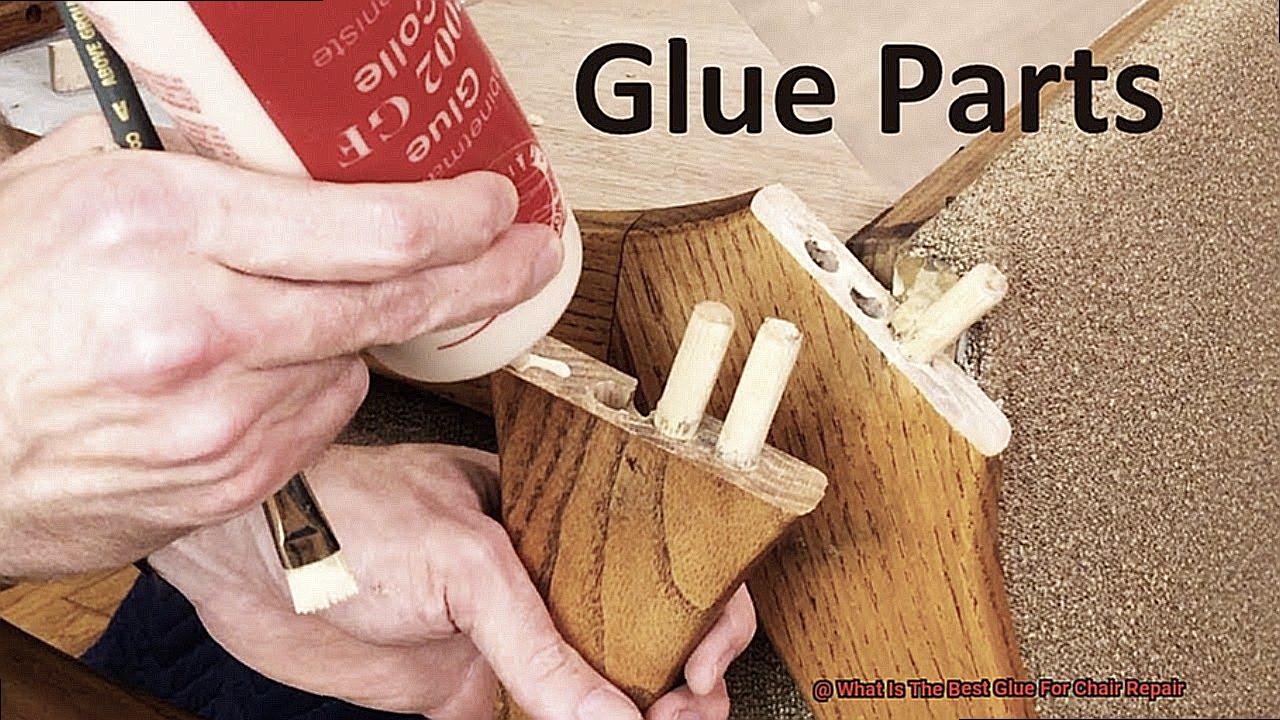
Is your chair’s fabric looking a little worse for wear? Fear not. Fabric glue and upholstery adhesive are specially designed to create a secure bond without damaging delicate materials. Simply apply these glues to the edges or seams of the fabric and let them do their thing. Your chairs will be dressed to impress in no time.
Polyurethane Glue – Flexibility and Strength:
When it comes to bonding different materials together, polyurethane glue is a fantastic choice. This adhesive is known for its flexibility and strength, making it suitable for chair repairs involving multiple materials or joints that require some give. Whether you’re fixing a wooden chair with metal accents or attaching plastic components, polyurethane glue has got your back.
Construction Adhesive – Heavy-Duty Support:
For chairs that need extra strength and durability, construction adhesive is the way to go. This heavy-duty adhesive is commonly used in carpentry and woodworking projects, providing a strong bond between different materials such as wood, metal, and plastic. Whether you’re repairing a chair with multiple components or reinforcing weak joints, construction adhesive will ensure your chairs can handle anything life throws at them.
qK0IR8WT_jE” >
Conclusion
When it comes to chair repair, finding the best glue is essential.
You want a glue that will provide a strong bond, withstand daily use, and last for years to come. After careful research and testing, we have determined that epoxy resin glue is the top choice for chair repair.
Its superior strength and durability make it perfect for fixing loose joints or broken pieces. Additionally, epoxy resin glue dries clear, ensuring a seamless repair that won’t detract from the chair’s appearance.
So next time you’re faced with a wobbly chair or a cracked leg, reach for epoxy resin glue and restore your chair to its former glory.



